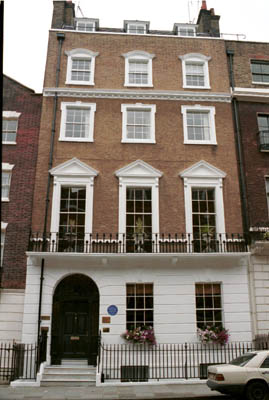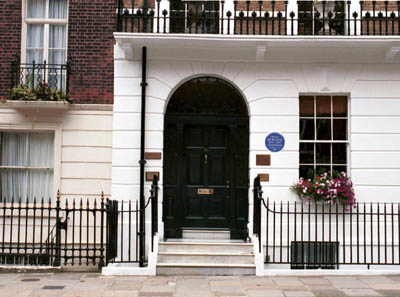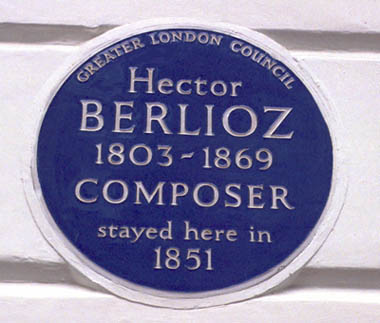This page is also available in French
![]()
Berlioz stayed in this house during his second visit to London as a member of the international commission examining musical instruments at London’s celebrated Great Exhibition of 1851 (see the page on Crystal Palace – 1851 Exhibition). The house belonged apparently to a friend of his, Adolphe Duchêne de Vère, who lived in London (cf. Correspondance générale no. 1411).
Berlioz used to walk from this house everyday to Hyde Park where Crystal Palace was located. In his Les Soirées de l’orchestre (21st evening, from the Journal des Débats, 20 June 1851) he describes one of his daily walks which started very early in the morning:
London was still asleep. None of the Saras, Marys, and Kates who every morning wash the doorsteps of houses was turning up as yet with a mop in their hand. An old Irish woman, drunk with gin, was smoking her pipe, sitting alone in a corner of Manchester Square. Lazy cows were ruminating, lying in the thick grass of Hyde Park. The small three-masted ship, that plaything of a seafaring people, was rocking drowsily on the Serpentine river. A few rays of light were beginning to shine from the high windows of the palace that is open to all people that on earth do dwell.
The house, with ‘its staircase and fine double drawing-room, decorated in the Adam style’ (Ganz [1950], p. 93), is still standing. At the time of Berlioz’s stay it also housed the Beethoven Room, in which the meetings of the Beethoven Quartet Society used to take place. Berlioz writes about it in Les Soirées de l’orchestre (21st evening, from Journal des Débats, 31 May 1851):
This room can hold up to two hundred and fifty people, and as a result it is often hired for concerts that are intended for small audiences, and there are many of them. Now the door of my flat opens on the staircase that leads to it, and so it was easy for me to hear everything that was being played there just by opening the door. One evening I heard the sounds of Beethoven’s piano trio in C minor [opus 1, no. 3] … I open the door wide … Welcome, proud melody, come in!… Heavens, how noble and beautiful it is! Where in the world did Beethoven discover those thousands of phrases, each more poetically characterised than the other, all different, all original, without even that family resemblance which can be recognised in the works of famous masters known for their prolific output? What ingenious developments! What unexpected turns!… How this eagle soars on his wings! How he glides and floats in his harmonious sky!… He dives, loses himself, rises, falls again, and disappears… He then returns to his starting point, his eyes even brighter, his wings stronger, impatient of rest, quivering, thirsting for infinity… Very well executed! Who can have been playing the piano part?… My servant tells me she is English. No question, a real talent!… Ouch! what is this? a big aria for a prima donna?… John, hurry, hurry, shut the door. Wretched woman! I can still hear her. Shut the second door, and the third; is there a fourth?… At last… I can breathe again…
![]()
All the photos reproduced on this page were taken by Michel Austin in 2001. © Monir Tayeb and Michel Austin. All rights of reproduction reserved.




No. 27 (now no. 58) is the third house on the left.
![]()
© Monir Tayeb and Michel Austin for all the pictures and information on this page.
Copyright notice: The texts, photos, images and musical scores on all pages of this site are covered by UK Law and International Law. All rights of publication or reproduction of this material in any form, including Web page use, are reserved. Their use without our explicit permission is illegal.